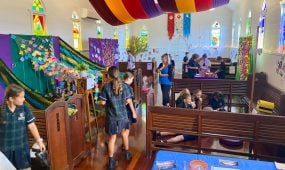Why are ‘Welcome to Country’ and ‘Acknowledgement of Country’ important?
Features
ACSQ RAP Coordinator Sandra King OAM explains why it is important to include a ‘Welcome to Country’ or an ‘Acknowledgement of Country’ at events and key gatherings

My name is Sandra King and I am a Quandamooka (Stradbroke Island) and Bundjalung (Tweed Heads) woman, born on Yuggera/Ugarapul (Brisbane) country. I am the new Reconciliation Action Plan Coordinator for the Anglican Church Southern Queensland. I am frequently asked about Aboriginal and Torres Strait Islander protocols and traditions and why it is important to include a ‘Welcome to Country’ or an ‘Acknowledgement of Country’ at events and key gatherings, so I hope this helps answer such queries.
Since I was a young girl I was taught to ‘respect your elders’ and ‘know your place’. Growing up, ‘knowing my place in society’ meant ‘don’t expect to be included’. Throughout my childhood this was evident and as a young adult walking into a shop, business or attending meetings, conferences and functions I was filled with anxiety as I did not know if ‘I would be acknowledged or included’. This unease still happens today. My life has been complicated, frustrating and sometimes horrific where my vulnerability, skin colour and race have been continued reminders of being born an ‘Aboriginal’ and not as a human being first and foremost. Having said that, I do feel I have lived a blessed life, a life I would not change at all, as my mistakes and the lessons the world has taught me have made me a strong and proud Aboriginal woman who walks in two worlds with the guidance of my ancestors and ‘silent partner’ (God).
Why is it important to do ‘Welcome to Country’ or ‘Acknowledgement of Country’ at gatherings?
Whether the gathering is with our Aboriginal and Torres Strait Islander community or at an ‘Indigenous’ or mainstream conference, it is important to hear ‘Welcome to Country’ or ‘Acknowledgement of Country’ before the start of the program. This is the first step of Reconciliation as it demonstrates acknowledgement, acceptance and respect towards Aboriginal and Torres Strait Islanders, their struggles and that they are the custodians of this beautiful land.
Advertisement
Even though our community leaders have long attended meetings or gatherings (usually with officials or government representatives), their voices largely fell on deaf ears. They had to listen to the ‘experts’ tell them what is best for our people and this infuriated them as they were once again excluded. Hearing businesses, not-for-profit organisations or clergy do an ‘Acknowledgement of Country’ is a huge step forward in breaking barriers. For me, it validates that my presence is welcomed, recognised and included. ‘Knowing my place’ in this way helps put a smile on my face, as I do not have to prove my worth or standing as a human being and a proud Quandamooka/Bundjalung woman.
If there is no Aboriginal or Torres Strait Islander person present and you do an ‘Acknowledgement of Country’ you are standing firm with truth and challenging outdated or prejudiced perceptions.
Who does ‘Welcome to Country’?
‘Welcome to Country’ can only be presented by a Traditional Owner of the land the gathering is meeting on. If you do not know who the Traditional Owners are from your area, please ring an Indigenous organisation that is in the area and, if possible, it might be best to also arrange to meet with the Manager, CEO or Board Members to introduce yourself and your parish. Most Traditional Owner groups will require a nominal fee to cover the cost of conducting the ‘Welcome to Country’.
Advertisement
When a Traditional Owner is not present or available to do the ‘Welcome to Country’, then an ‘Acknowledgement of Country’ is the next best option.
Who does ‘Acknowledgement of Country’?
This person can be the MC / Event Organiser or a First Nations Person (who is not a Traditional Owner of the area) before the start of the program. As stipulated above, if you do not know who the Traditional Owners are, please ring an Indigenous organisation that is in the area.
How do we do the ‘Acknowledgement of Country’?
Example 1: I acknowledge the ‘Traditional Owners’ (please state the name of the traditional group/clan) of the land where we gather today and their Elders, past, present and emerging.
Example 2: I respectfully acknowledge the (please state the name of the traditional group/clan) Traditional Owners of the land on which this event is taking place and their Elders, past, present and emerging.
An appropriate prayer may follow your ‘Welcome to Country’ or ‘Acknowledgement of Country’.
Editor’s note 12/04/2023: Text updated.





